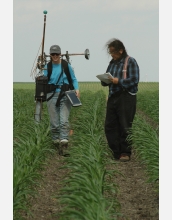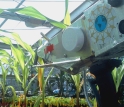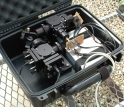News Release 05-120
Field of Beams
Novel system uses polarized light pulses to reveal crop health

Margaret Ingalls (left) and Steve Finkelman measure properties of corn leaves using the N-Checker.
July 19, 2005
This material is available primarily for archival purposes. Telephone numbers or other contact information may be out of date; please see current contact information at media contacts.
By firing rapid pulses of polarized light at corn, spinach and other crops, researchers have uncovered a picture of plant health that is invisible to the naked eye. Using a portable light source and detector technology, the researchers can differentiate minute differences in leaf colors - indicators of over- or under-fertilization, crop-nutrient levels and perhaps even disease.
The researchers hope their tractor-mountable N-Checker (for "nitrogen-checker") apparatus will help farmers determine in real time how much fertilizer to apply. By preventing waste, the system could decrease the cost of crop production and dramatically cut the nitrogen-laden runoff responsible for algal blooms and other damage to wetlands and waterways.
Steve Finkelman, Paul Nordine and their colleagues at Containerless Research, Inc. of Evanston, Ill., Louise Egerton-Warburton and partners at the Chicago Botanic Garden, and graduate student Tim Smith of the University of Illinois, Urbana-Champaign, will present their new technology July 19 at the InfoAg 2005 Conference in Springfield, Ill.
"With our technology, we are able to easily see what is hidden from conventional instruments," says Finkelman. "The system eliminates interference from light reflected at a leaf's surface and allows us to see light re-emitting from within."
Depending on the plant, leaves reflect, transmit and absorb varying amounts of light. Polarized light that enters a leaf's interior can lose its polarity and be re-emitted as "depolarized" light. The depolarized light reveals nitrogen content and other properties the proprietary sensors in the N-Checker can detect.
Changes in nitrogen levels change the way light interacts with the molecules in the leaf, characteristically affecting the spectrum of light that re-emits from the plant. Chlorophyll molecules, in particular, contain nitrogen atoms that play a critical role in photosynthesis.
The researchers have experimented with two versions of their apparatus. The original version channels broad-spectrum light from a xenon flashlamp through a series of calcite crystals to illuminate each corn, sugar beet, cotton or other broad-leaf crop with a tiny, transient spot of polarized light. Moving from leaf to leaf, that system can measure nitrogen levels in 60 plants per minute.
Instead of a broad-spectrum lamp as its source, the N-Checker uses two red-light sources that cut down on sensor and polarizer costs and increase the system speed. The red region of the electromagnetic spectrum is important because it reveals not just total chlorophyll content, but also relative amounts of the various types of chlorophyll molecules.
"Other devices use both red and infrared wavelengths," says Finkelman. "Those devices tend to be imprecise because they measure bulk chlorophyll content, which can result from a number of factors." By using two specific, visible, red wavelengths, the N-Checker can differentiate among the several types of chlorophyll molecules and therefore reveal nitrogen-dependent plant health information.
The N-Checker can take 1000 measurements per second--at least every 10th of an inch--while moving at roughly 5 miles an hour. At that speed, a farmer could survey and fertilize tens of acres in a day, or hundreds of acres per day with a multi-sensor system.
This research was supported by NSF Grant #DMI-0319826
SBIR Phase I: Polarization Sensing of Stress Levels in Vegetation
http://www.nsf.gov/awardsearch/showAward.do?AwardNumber=0319826
-NSF-
-
This image shows the original depolarized light-sensor apparatus assessing plant leaves.
Credit and Larger Version -
This image shows the N-Checker sensor components within a protective carrying case.
Credit and Larger Version
Media Contacts
Joshua A. Chamot, NSF, (703) 292-7730, email: jchamot@nsf.gov
Dileep Gangoli, Containerless Research, Inc., (847) 467-7179, email: dileep@waldenanalytics.com
Program Contacts
Om P. Sahai, NSF, (703) 292-7795, email: osahai@nsf.gov
Principal Investigators
Steven Finkelman, Containerless Research, Inc., (847) 467-2678, email: finkelman@containerless.com
Co-Investigators
Paul Nordine, Containerless Research, Inc., (847) 467-2678, email: pnordine@containerless.com
Louise Egerton-Warburton, Chicago Botanic Garden, (847) 835-6915, email: lwarburton@chicagobotanic.org
Related Websites
CRI Remote Sensing Technology: http://www.containerless.com/RemoteSensing.htm
Louise Egerton-Warburton homepage: http://www.chicagobotanic.org/research/conservation/egerton.html
The U.S. National Science Foundation propels the nation forward by advancing fundamental research in all fields of science and engineering. NSF supports research and people by providing facilities, instruments and funding to support their ingenuity and sustain the U.S. as a global leader in research and innovation. With a fiscal year 2023 budget of $9.5 billion, NSF funds reach all 50 states through grants to nearly 2,000 colleges, universities and institutions. Each year, NSF receives more than 40,000 competitive proposals and makes about 11,000 new awards. Those awards include support for cooperative research with industry, Arctic and Antarctic research and operations, and U.S. participation in international scientific efforts.
Connect with us online
NSF website: nsf.gov
NSF News: nsf.gov/news
For News Media: nsf.gov/news/newsroom
Statistics: nsf.gov/statistics/
Awards database: nsf.gov/awardsearch/
Follow us on social
Twitter: twitter.com/NSF
Facebook: facebook.com/US.NSF
Instagram: instagram.com/nsfgov




